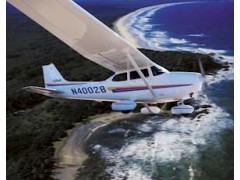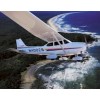We tailor your flight training to fit YOUR schedule and budget. An ideal schedule for a person seeking a private pilot certificate would have you taking at least one to two lessons per week, with completion in about 6 months. As with any learning process, the more often you train the less you have to re-learn as you go along. However, if once a week or twice a month is all you can manage, you will succeed in becoming a pilot as well. EFI’s experienced instructors are dedicated to making sure you do!
Training Syllabus
The ground and flight training program at EFI is based principally upon information contained in the FAA’s Private Pilot Practical Test Standards, Airplane Flying Handbook and Pilot’s Handbook of Aeronautical Knowledge. From this material, EFI has developed a “Private Pilot Directed Study Guide and Flight Training Syllabus” to take you through our comprehensive flight training program. You can preview new lessons and track your progress through each phase of the training program all the way through to completion of all requirements. Your training will consist of four phases: Pre-Solo; Cross Country; Night Flying; and Preparation for the Practical Test.
Pre-Solo. In the first phase of training, you’ll learn about: Preflight Procedures; Airworthiness Requirements; Certificates and documents; Aerodynamics of Flight; Operation of Aircraft Systems; Aircraft Flight Instruments; Technically Advanced Aircraft Systems; Airport Operations; Air Traffic Control Communications; Takeoffs, Landings and Go-Arounds; Basic Flight Maneuvers; Slow Flight and Stalls; Emergency Operations and Equipment Malfunctions; Ground Reference Maneuvers; and Weather Information (Basic) for your solo flights. During this phase of training, you’ll make three solo flights under the supervision of your flight instructor.
Cross Country. In the second phase of training, you’ll learn about: National Airspace System; Fundamentals of Navigation; VOR Navigation; GPS Systems; Non-Directional Beacon Navigation; Flight by Reference to Instruments; Performance Maneuvers; Aircraft Performance and Limitations; Takeoffs and Landings; Weather Information (Advanced) for your cross country flights; Cross Country Flight Planning; and Physiological, Psychological and Medical Factors. During this phase training, you’ll make dual cross country flights with your instructor followed by solo cross country flights.
Night Flying. In the third phase of training, you’ll learn about: Night Vision; Night Illusions; Pilot Equipment; Airplane Equipment and Lighting; Position Lights; Airport and Navigation Lighting Aids; Preparation and Preflight; Approaches and Landings; and Night Emergencies. During this phase of training, you’ll make at least 10 night landings to a full stop with your instructor and a complete a dual cross country flight. There is no requirement to fly solo at night.
Preparation for the Practical Test. In the final phase of training, you’ll review and practice all of the maneuvers you can expect to fly on your private pilot check ride. Working closely with your flight instructor, you’ll be well prepared for the oral examination and flight test.
Flight training takes place principally in one of our Cessna Skyhawks. We also have an Advanced Aviation Training Device (AATD) on site that may be used for a portion of your training. An AATD is commonly referred to as a “flight simulator” and is an excellent tool for introducing a number of subjects including various forms of air navigation and emergency procedures. Whether training takes place in the “flight simulator” or in the airplane, you’ll learn the skills and gain the experience necessary to safely operate an airplane on your own – and pass your check ride.
Basic Requirements
Flight instruction may begin at any age, but before you begin flight training the prospective student should consider the basic requirements:
Citizens of the U.S. must present proof of citizenship prior to beginning flight training.
Non-U.S. citizens must apply for and receive TSA approval prior to beginning flight training.
You must be at least 16 years of age to solo.
You must be 17 years of age to receive a Private Pilot Certificate.
You must be able to obtain at least a 3rd Class Medical Certificate prior to your first solo.
You must be able to read, speak and understand the English language.
Meet the FAA minimum flight time requirements.
Pass the FAA written exam.
Pass the FAA oral exam and practical test.
Student Pilot/Medical Certificate
A Student Pilot/Medical Certificate is not required before you begin ground school or during the earliest part of flight training. However, we do recommend that you obtain at least a third class medical and student pilot certificate after you’ve taken a few lessons. Of course, you must have the medical and student pilot certificate in your possession prior to your first solo flight. We have a list of local aviation medical examiners available in the office who can provide the physical examination and issue you the proper documentation.
Transportation Security Administration (TSA) Requirements
If you are receiving flight training in an aircraft weighing less than 12,500 pounds, whether you are a U.S. citizen or alien, TSA’s alien flight training/citizenship validation rule affects you.
U.S. Citizens: You are welcome to participate in a ”demonstration” or “discovery” flight prior to commencing pilot training for a new certificate or rating. However, you must present to the flight school a U.S. passport or birth certificate prior to commencing the first “flight training” lesson.
Non U.S. Citizens: You are welcome to participate in a “demonstration” or “discovery” flight prior to commencing pilot training for a new certificate or rating. However, you must begin a TSA authorization process that includes:
Notifying the flight school of your intent to take flight training.
Request authorization through TSA’s “Alien Flight Student Program.” The TSA authorization process has several steps that includes, but is not limited to: presenting proper documentation, submitting finger prints and submitting a photograph. There is a TSA processing fee associated with this program.
once TSA authorization is received by the flight school and/or your flight instructor, “flight training” can commence.
For more information please go to the Aircraft Owners & Pilots Association or the TSA web site regarding the Alien Flight Student Program.





